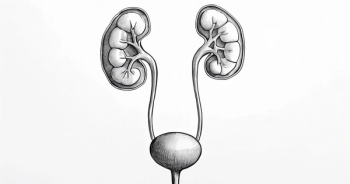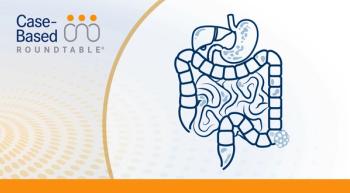
Stein Reviews State of Frontline Therapy for Unresectable HCC

During a Community Case Forum event, Stacey Stein, MD, discussed data guiding the use of current regimens for the treatment of unresectable hepatocellular carcinoma.
CASE SUMMARY
- A 65-year-old man with a 10-year history of type 2 diabetes presented with upper quadrant pain.
- History: no history of hepatitis B virus infection; nonalcoholic
- ECOG performance status: 0; BMI: 38 (morbidly obese)
- MRI showed a cirrhotic liver, 3 enhancing lesions in the right lobe (4.5 × 3.5 cm; 2.6 × 5.2 cm; 3.7 × 3.2 cm), and a 5-cm mass in the left lobe, all category 5 per Liver Image Reporting and Data System; main portal vein tumor thrombus (Vp4)
- Noncontrast CT showed evidence of portal hypertension with splenomegaly.
- Child-Pugh score: A (CPA); no ascites or hepatic encephalopathy
- α-Fetaprotein: 2000 ng/mL
Peers & Perspectives in Oncology: How has the treatment of unresectable hepatocellular carcinoma (uHCC) evolved over time?
STEIN: When I started as an attending physician, we had one drug available, sorafenib [Nexavar], with a very modest overall survival [OS] benefit. There were multiple negative studies at that time. Things got much more exciting in the past few years with the addition of immunotherapy. First, there was single-agent data with nivolumab [Opdivo] and pembrolizumab [Keytruda], but then we saw better response rates and survival with the doublet regimens. Atezolizumab [Tecentriq] and bevacizumab [Avastin] was the first regimen to show [benefit as] a doublet from the IMbrave150 study [NCT03434379]; it raised OS and progression-free survival [PFS] rates vs sorafenib. We have durvalumab [Imfinzi] plus tremelimumab [Imjudo], and we have ipilimumab [Yervoy] plus nivolumab in the second line, and we have the sequential tyrosine kinase inhibitors [TKIs].
The scoring for vascular invasion goes from Vp1 to Vp4. Vp4 [indicates the disease is] in the main [portal] trunk; Vp3 [signifies] it’s further up [in the first-order branches]; Vp2 [indicates it is in the second-order branches]; and [in Vp1, it] is very distal.1 The higher the number, the more complicated the treatment is.
CASE UPDATE
- Biopsy was obtained and confirmed moderately differentiated HCC (CPA, Barcelona Clinic Liver Cancer C) with microvascular invasion.
What role does Child-Pugh score currently have in the treatment of uHCC?
There are limited safety data…. Some small studies have looked at real-world experience with Child-Pugh B [disease] and very rarely with those with Child-Pugh C disease. I have a bunch of those patients on treatment, but you have to think about their level of function and their performance status and what you think is safe to do.
The NCCN recently removed the Child-Pugh classification from the guidelines.… I’m not representing NCCN guidelines, but [in 2023], we talked about this, and we decided to take it out of the guidelines.2 The thought process was that when you think about all clinical trials, we’re constantly extrapolating treatment decisions for patients who never fit all the criteria for any of the studies. Keeping Child-Pugh [scoring] in almost seems like we were differentiating HCC in a way that people don’t differentiate, [for example,] colorectal cancer, where we would say, every patient on the study had to have a hemoglobin of more than 9.0 g/dL to go in that study, and therefore the regimen is only for patients with a hemoglobin greater than 9.0 g/dL. Or if the study only included patients with an ECOG performance status of 0 or 1, and this patient has a performance status of 2.
So we removed it. This is not to say that you should not think about Child-Pugh [scoring] or that you should treat all the patients the same and be blind to it, but to say that, realistically, we see a lot of patients with Child-Pugh B [disease], and it’s up to every oncologist’s judgment to decide how to treat when the patient doesn’t exactly fit the enrollment criteria of a study.
We’ve also experienced insurance companies using it as an exclusion. I had insurance companies recently pushing back and saying I need to show the Child-Pugh score, and I said, “No, I don’t.” I think having it in the guideline was becoming a barrier for treatment for patients whose disease was not [categorized as] Child-Pugh A. [However], you still have to think about the Child-Pugh score.
Could you describe the design and outcomes of the IMbrave150 study?
IMbrave150 was based on the phase 1 study that had shown a 36% objective response rate [ORR]. In this study, patients were randomly assigned to atezolizumab/bevacizumab or to active surveillance. They were allowed to have crossover. They had to have the screening endoscopy and good performance status. Approximately three-fourths of the patients had macrovascular invasion, extrahepatic spread, or both, and approximately 40% of both arms had macrovascular invasion.3 Approximately half of the trial patients enrolled in Asia so that [contributed to] the 50% of patients with hepatitis B [etiology].
We saw in the primary analysis that the median OS was not estimable [with atezolizumab/bevacizumab vs 13.2 months with sorafenib].3 Then, it was updated to 19.2 months [vs 13.4, respectively], with a median PFS of 6.9 months [vs 4.3, respectively].4
What you miss sometimes in these median numbers, especially with the PFS, is that you have that group that drops off [quickly], and the median doesn’t tell you how well the responders do. Because we have no biomarker in HCC, we’re not using any scoring system for these patients. We’re offering it to all comers. Sometimes, you lose [track of] the patients who do well in these medians. But here, the ORR was 30% with atezolizumab/bevacizumab with [8%] complete response and [22%] partial response, and over 40% with stable disease, so the disease control rate was more than 70%.3
In terms of safety, we didn’t see the typical TKI adverse events [AEs], but then we did see some autoimmune AEs.4 There were a few [fatal] bleeding events, but the 5 patients who [died because of] upper gastrointestinal [GI] bleeding had either Vp3 or Vp4 macrovascular invasion, which led to more portal hypertension. Only one of them was thought to be from the drugs.
Looking at the patients by baseline varices status…you can see more of a separation of those who had varices.5 The HR for PFS by varices was 0.55 [95% CI, 0.37-0.83] for those with varices and 0.67 [95% CI, 0.52-0.87] without varices. However, the ORR was the same for both groups.
Looking at a very granular level of the GI bleeding rate from the study, out of 87 patients who had [baseline] varices, 7% had [esophageal varices hemorrhage] and 6% had gastrointestinal hemorrhage. So, it was relatively low, and it’s not like there’s no bleeding with sorafenib because you still have VEGF inhibition.
How was combination immunotherapy investigated in this setting?
The phase 3 HIMALAYA study [NCT03298451] looked at the use of tremelimumab and durvalumab. They had the benefit of knowing from the ipilimumab/nivolumab data that when you give 4 doses of the ipilimumab, some patient populations tolerate that better than others, and I think the HCC population, in general, tolerates [therapies] less well. I only treat patients with GI cancers…and when lenvatinib [Lenvima] first came out, I realized that the thyroid cancer trial went up to a 24-mg dose, whereas patients with HCC barely tolerate a 12-mg dose. A lot of patients are at 8 mg or even 4 mg. They’re different patient populations.
So, it was a smart design to say that this is a group that we shouldn’t try to give 4 doses of a CTLA-4 antibody and [instead] do a single priming dose [of tremelimumab]. Then, there was a durvalumab [monotherapy] arm; this arm closed early, so we’re not considering that in the analysis. [The arms were] the combination of a single priming dose [of tremelimumab with durvalumab], durvalumab alone, and sorafenib, and the primary end point was the OS for the combination vs sorafenib. There was a secondary objective of OS for durvalumab vs sorafenib. We’re looking at 2 different OS comparisons to sorafenib. This is a similar patient population [to IMbrave150], and there was [more than] 25% with microvascular invasion and 50% with extrahepatic spread in this study.6
It’s amazing now that we have 5-year survival data from the HIMALAYA study. When I think back to when we just had sorafenib, it’s amazing to be talking about 5-year data. The median OS—again, I think we’re missing these arms of the curve when we only think about the median—but the STRIDE [single tremelimumab regular interval durvalumab] regimen was 16.43 months, the durvalumab-alone arm was [16.56 months], and then the sorafenib arm keeps getting better as time goes on, reflecting that most patients go on to another therapy after and probably got immunotherapy, [showing a median OS of] 13.77 months.6,7 But there is a separation of curves [HR favoring STRIDE of 0.78; 96.02% CI, 0.65-0.93]. The median PFS was not any better with STRIDE [HR, 0.90; 95% CI, 0.77-1.05] because these median PFSs are not telling the full story here. The ORR was 20% with the STRIDE regimen vs 5% with sorafenib. These studies always show a response to sorafenib…higher than I usually see.
In terms of grade 3/4 AEs, there were some immune-related grade 3/4 AEs, and the use of steroids on the STRIDE regimen was about 20%. That is something I think about, especially for the less-compensated patients who are higher up on the Child- Pugh B scale. If this patient had to go on a high-dose steroid regimen, could they tolerate that…? The rate of steroid use on the single-agent durvalumab arm was about 10%, and it wasn’t published in the IMbrave150 study, but I believe the rate of steroid use in that study was about 12%.
Going back to the patients with Vp4 [disease]…patients with tumor thrombus in the main trunk or contralateral portal vein are the patients [with Vp4 disease].8 Those patients were excluded from HIMALAYA and REFLECT [NCT01761266], the lenvatinib vs sorafenib study. In the IMbrave150 study, [there were 67 of 485 patients who had] Vp4, and there was a percentage of patients who had hemorrhage, as opposed to sorafenib, so there is a bit more risk. It’s hard when you don’t have data for this group in the other studies to know how to compare, but still, out of 67 patients, it was a relatively small group. Most of the patients did not have bleeding. You could argue that that number might differ in a regimen without bevacizumab, but we don’t have any data for those patients with the STRIDE regimen.
DISCLOSURE: Stein previously reported fees from AbbVie, AstraZeneca, Genentech, Eisai, and Merck.






































